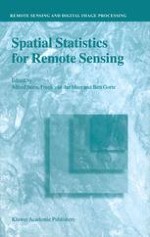2002 | OriginalPaper | Buchkapitel
Issues of scale and optimal pixel size
verfasst von : Paul J. Curran, Peter M. Atkinson
Erschienen in: Spatial Statistics for Remote Sensing
Verlag: Springer Netherlands
Enthalten in: Professional Book Archive
Aktivieren Sie unsere intelligente Suche, um passende Fachinhalte oder Patente zu finden.
Wählen Sie Textabschnitte aus um mit Künstlicher Intelligenz passenden Patente zu finden. powered by
Markieren Sie Textabschnitte, um KI-gestützt weitere passende Inhalte zu finden. powered by
The environment interacts differentially with electromagnetic radiation according to its essential physical, chemical and biological properties. The electromagnetic radiation recorded by an imaging sensor has value because (i) it can represent these essential physical, chemical and biological properties spatially and (ii) can be used to provide information on our environment; for example, its biomass, cover, temperature. However, points in the environment that are near to each other are more alike than those that are further away and the degree of dissimilarity depends upon spatial autocorrelation in the environment and the pixel size of our remotely sensed observations. In other words, space isn’t a parameter it is a variable and relationships between remotely sensed data and ground data derived at one scale will not be the same at another. The spatial dependence in remotely sensed data is both a burden and a challenge. A burden in the sense that we need to account for the influence of space (other chapters in this book) but a challenge in that in choosing the spatial dimensions of our measurements we can do so to our advantage. This chapter has discussed one such example where spatial statistics were employed to select the optimum pixel size for a given remote sensing investigation.The realization that we need to choose a pixel size is the first stage in exercising that choice. The message of this chapter is that as remote sensing is inherently spatial “it is a geographical fact of life that the results of spatial study will always depend on the areal units that are being studied” ([289]: p.37).
